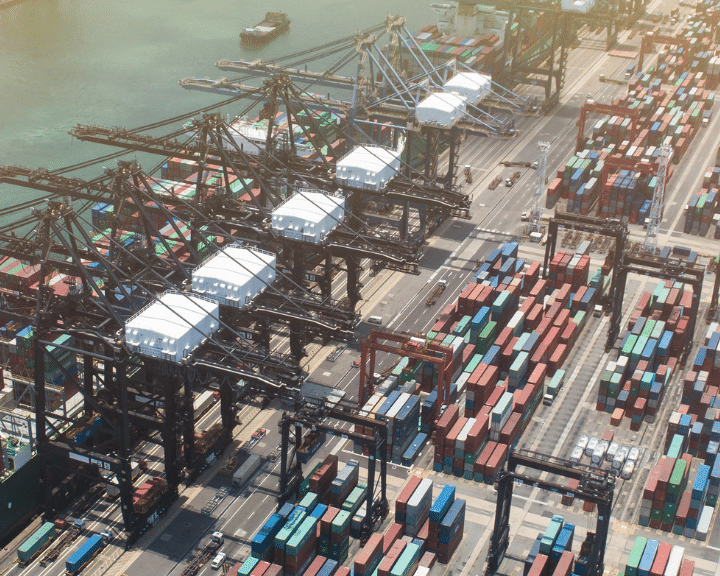Supply chain digitization prepares your company for resilient growth at any pace, and helps you seize opportunities to scale your business, whether you’re processing ten transactions a day or 10 million.
Digital Transformation In Supply Chain
Companies, from small businesses to large enterprises, have been increasingly embracing digital transformation for its ability to maximize efficiency throughout an organization. Digital transformation, which is the integration of digital technology into a company’s day-to-day operations and processes, is recognized for its ability to enhance the performance of every department.
What is supply chain digital transformation?
Digital transformation in logistics and supply chain replaces the traditional supply chains, which are based on manual processes, including manual data input and reporting that often lead to departments and partners working in silos.
With digital supply chain management, manual processes can be significantly improved through technologies that connect companies and suppliers. As a result, digital transformation in supply chain leads to transparency and real-time visibility internally about the status of an order, inventory levels, potential disruptions, and other factors.
Digital transformation in supply chain can include the integration of advanced technologies, including artificial intelligence, analytics, and robotics to collect and process information that allows team members to automate functions and make informed decisions throughout the supply chain.
Through a higher level of visibility, team members can be more agile and proactive in addressing challenges in the supply chain and improve communications with suppliers and other partners.
Many companies also notice increased customer satisfaction as well as increased efficiencies when implementing digital transformation in supply chain, as it helps them regularly identify ways to improve processes and maintain an edge over their competitors.
Major retailers, for example, have embraced the idea of integrating digital technologies in the supply chain, such as automated tracking systems, to provide their online customers with real-time information about when their orders have been received, when they have been shipped from their warehouse, and when they are expected to be delivered to their door. Similarly, freight forwarders have integrated real-time visibility data directly into their TMS to allow their retail customers to track the status of their shipments. Overall, it can lead to an enhanced customer experience through all stages of the purchasing process.
PwC digital trends in supply chain survey 2022
PricewaterhouseCoopers, an international professional services network, regularly releases digital trends in supply chain reports. The latest report, PwC Digital Trends in Supply Chain Survey 2022, includes feedback from 244 operations and information technology leaders, supply chain officers, and C-suite executives from various industries, including automotive, retail, manufacturing, utility, and pharmaceuticals.
According to the 2022 report, the world’s supply chains are facing increased pressure to boost efficiencies and improve customer service, especially with increased demands caused by the COVID-19 pandemic and related disruptions to various industries.
The leaders surveyed also reported that the pandemic triggered the need to update and upgrade supply chains in a world that has become increasingly digital. Other findings included that many companies are challenged in finding the right talent, especially with a majority of respondents indicating that they are seeing higher-than-normal turnover rates among supply chain employees. Regulatory changes also were cited as a concern.
Importance of Digital Transformation In Supply Chain
As indicated in the PwC Digital Trends in Supply Chain Survey 2022, the importance of digital transformation in supply chain has intensified with consumer demands for shipped products amid the COVID-19 global pandemic.
According to the report, many survey respondents are still concerned about risks, some moderate and some major, posed by numerous attributes of their supply chains and suppliers.
Impact of Digitization on Supply Chain Management
Companies that have leveraged digitization of supply chain management may be in the best position to navigate the challenges brought on by disruptions in their industries.
For instance, freight forwarders, 3PLs, 4PLs, and other logistics providers, can leverage the advantages of digital supply chains to ensure that they are connecting to their customers more effectively and more quickly, even in the event of a delay in the shipment of a package. By delivering transparency, these companies can increase customer satisfaction.
Besides improved customer service, other advantages of a digital supply chain include increased efficiency, improved visibility into operations, the ability to better anticipate disruptions, and reduced costs.
The Future of Supply Chain 2022
With the ongoing challenges facing companies in the supply chain, from high rates of turnover, delays in cargo shipments, and material shortages, many experts are hopeful that conditions will start to improve in the near future.
Some areas that have been identified include:
- Diversifying supplier sources to reduce dependencies on a small number of suppliers.
- Increasing the focus on inventory optimization strategies, whether on materials, products, and warehousing.
- Leveraging supply chain digitization to improve collaboration and enhance transparency among suppliers, 3PLs, 4PLs, and other partners in the supply chain.
- Increasing the focus on sustainability and sourcing sustainable materials.
- Exploring ways in which machine learning and artificial intelligence can improve business models and enable employees to make more real-time decisions.
Where to Start With Digital Transformation in Supply Chain
With the advantages that can be gained through the process of supply chain digitization, many business leaders have started to explore supply chain technology and supply chain training for their organizations.
While digitally transforming a supply chain can be a lengthy process, it is important to understand that successful implementation can result in numerous advantages in an increasingly competitive market.
It is important to initiate the digital transformation in the supply chain in small stages. Here are several stages to keep in mind:
Identify a specific goal. Instead of tackling all of the challenges within the various departments of your organization, choose a simple business process as your first milestone. For example, you can decide to enhance visibility throughout the phases of the supply chain.
Select a supply chain software provider. For expert guidance, work with a reputable supply chain software provider to get more data about your supply chain operations. Determine if the provider has had successful outcomes with organizations like yours. Request a supply chain digital transformation case study on a similar company to ensure that you are confident in the advice the provider will be able to provide for the next steps.
Request a supply chain audit of your organization. As part of the process, a supply chain software provider may conduct an audit to better understand supply chain business processes within your organization. An inventory of the existing systems and processes can help your team identify areas for improvement.
Develop a timeline. Set expectations among your team members by creating a timeline for the short-term and long-term goals of the software implementation. It is important to also create strategies and processes based on the findings of an audit and recommendations.
For example, through an engagement with Chain.io, a supply chain integrations expert, you can ensure all of your data is properly integrated as part of the process. Through consultation and partnership, your organization will be able to gain a clear understanding of the supply chain integrations that need to happen for your digital transformation.
Examples of Digital Transformation in Supply Chain
By enhancing the visibility of data throughout a company’s various departments and among critical partners, companies can minimize errors caused by manual work throughout the company and gain efficiencies throughout their operations.
Examples of digital transformation in supply chain include numerous business processes, including Supply Chain Visibility (SCV), ASN/milestone automation, robotic process automation, and CO2 data automation. Here are a few of those supply chain transformation examples explained:
Supply chain visibility (SCV): Supply chain visibility is another example of digital technology in supply chain management. SCV provides teams with the ability to track individual components (such as raw materials) and completed products as they make their way through the supply chain, from suppliers to manufacturers to consumers. from supplier to manufacturer to consumer. Through supply chain management technology, SCV provides real-time data about different aspects of the supply chain, including logistics, so that companies can be prepared to address bottlenecks, delays, inventory shortages, and compliance guidelines.
ASN/milestone automation: ASN/milestone automation simplifies the process of ensuring that buyers are kept up to date on when a supplier has shipped or plans to ship an order. Through Advanced Shipment Notification, information also may include details like the purchase order number, shipment notice number, shipping date, shipping source, delivery date, and shipment destination.
Robotic process automation (RPA): Digital supply chain companies also may offer RPA as a way for clients to gain efficiencies. By enabling AI, artificial intelligence, to be integrated with shipping management software, logistics managers can eliminate the need to complete numerous tasks, like providing updates, processing invoices, and monitoring schedules. With RPA, these functions can be automated.
Integrations for Supply Chain Digitization
Advanced integrations for supply chain digitization are key to the successful implementation of supply chain digitization solutions that streamline processes, enhance visibility among departments, suppliers, and partners, and enable teams to quickly address challenges throughout the supply chain.
Chain.io is experienced with helping companies in the supply chain industry, including logistics service providers (freight forwarders, 3PLs, and 4PLs), shippers, and software providers, start the process of digitizing their supply chain.
With Chain.io's pre-built adaptors, the digitization journey is faster, equipping teams with more visible, scalable, and functional supply chains in less time.
Chain.io integrates its customers' data directly into their TMS and WMS platforms from other data providers, like real-time transportation visibility platforms.
Start gaining the benefits of digital transformation in your supply chain, from extending real-time visibility throughout your supply chain, to enhancing collaboration and automation among all departments and partners.







